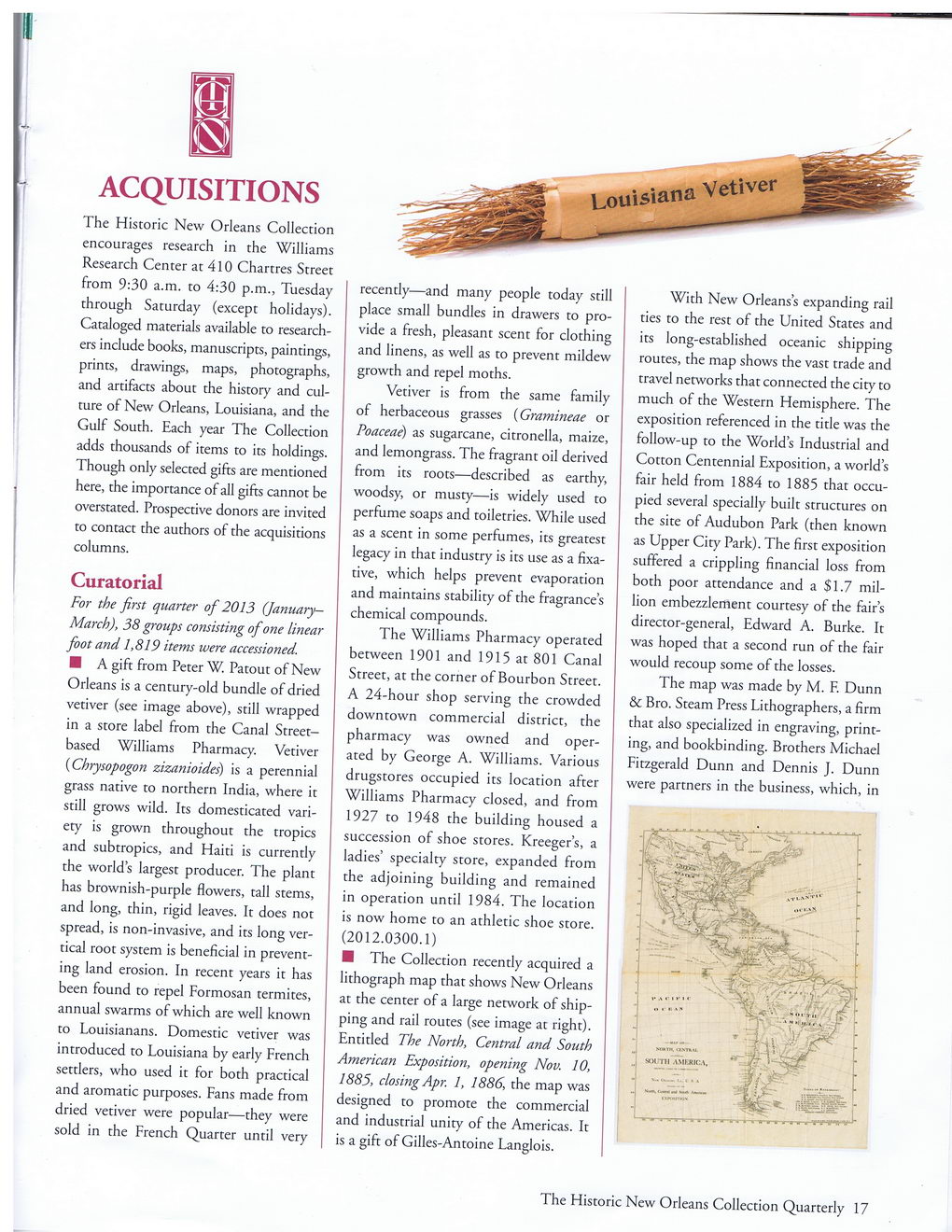This text was obtained via automated optical character recognition.
It has not been edited and may therefore contain several errors.
ACQUISITIONS The Historic New Orleans Collection encourages research in the Williams Research Center at 410 Chartres Street from 9:30 a.m. to 4:30 p.m., Tuesday through Saturday (except holidays). Cataloged materials available to researchers include books, manuscripts, paintings, prints, drawings, maps, photographs, and artifacts about the history and culture of New Orleans, Louisiana, and the Gulf South. Each year The Collection adds thousands of items to its holdings. Though only selected gifts are mentioned here, the importance of all gifts cannot be overstated. Prospective donors are invited to contact the authors of the acquisitions columns. Curatorial For the first quarter of 2013 (fanuary— March), 38 groups consisting of one linear foot and 1,819 items were accessioned. H A gift from Peter W. Patout of New Orleans is a century-old bundle of dried vetiver (see image above), still wrapped in a store label from the Canal Street-based Williams Pharmacy. Vetiver (Chrysopogon zizanioides) is a perennial grass native to northern India, where it still grows wild. Its domesticated variety is grown throughout the tropics and subtropics, and Haiti is currently the worlds largest producer. The plant has brownish-purple flowers, tall stems, and long, thin, rigid leaves. It does not spread, is non-invasive, and its long vertical root system is beneficial in preventing land erosion. In recent years it has been found to repel Formosan termites, annual swarms of which are well known to Louisianans. Domestic vetiver was introduced to Louisiana by early French settlers, who used it for both practical and aromatic purposes. Fans made from dried vetiver were popular—they were sold in the French Quarter until very recently—and many people today still place small bundles in drawers to provide a fresh, pleasant scent for clothing and linens, as well as to prevent mildew growth and repel moths. Vetiver is from the same family of herbaceous grasses (Gramineae or Poaceae) as sugarcane, citronella, maize, and lemongrass. The fragrant oil derived from its roots—described as earthy, woodsy, or musty—is widely used to perfume soaps and toiletries. While used as a scent in some perfumes, its greatest legacy in that industry is its use as a fixative, which helps prevent evaporation and maintains stability of the fragrance’s chemical compounds. The Williams Pharmacy operated between 1901 and 1915 at 801 Canal Street, at the corner of Bourbon Street. A 24-hour shop serving the crowded downtown commercial district, the pharmacy was owned and operated by George A. Williams. Various drugstores occupied its location after Williams Pharmacy closed, and from 1927 to 1948 the building housed a succession of shoe stores. Kreeger’s, a ladies’ specialty store, expanded from the adjoining building and remained in operation until 1984. The location is now home to an athletic shoe store. (2012.0300.1) H The Collection recently acquired a lithograph map that shows New Orleans at the center of a large network of shipping and rail routes (see image at right). Entitled The North, Central and South American Exposition, opening Nov. 10, 1885, closing Apr. 1, 1886, the map was designed to promote the commercial and industrial unity of the Americas. It is a gift of Gilles-Antoine Langlois. With New Orleans’s expanding rail ties to the rest of the United States and its long-established oceanic shipping routes, the map shows the vast trade and travel networks that connected the city to much of the Western Hemisphere. The exposition referenced in the title was the follow-up to the World’s Industrial and Cotton Centennial Exposition, a world’s fair held from 1884 to 1885 that occupied several specially built structures on the site of Audubon Park (then known as Upper City Park). The first exposition suffered a crippling financial loss from both poor attendance and a $1.7 million embezzlement courtesy of the fair’s director-general, Edward A. Burke. It was hoped that a second run of the fair would recoup some of the losses. The map was made by M. F. Dunn & Bro. Steam Press Lithographers, a firm that also specialized in engraving, printing, and bookbinding. Brothers Michael Fitzgerald Dunn and Dennis J. Dunn were partners in the business, which, in The Historic New Orleans Collection Quarterly 17

New Orleans Quarterly 2013 Summer (17)